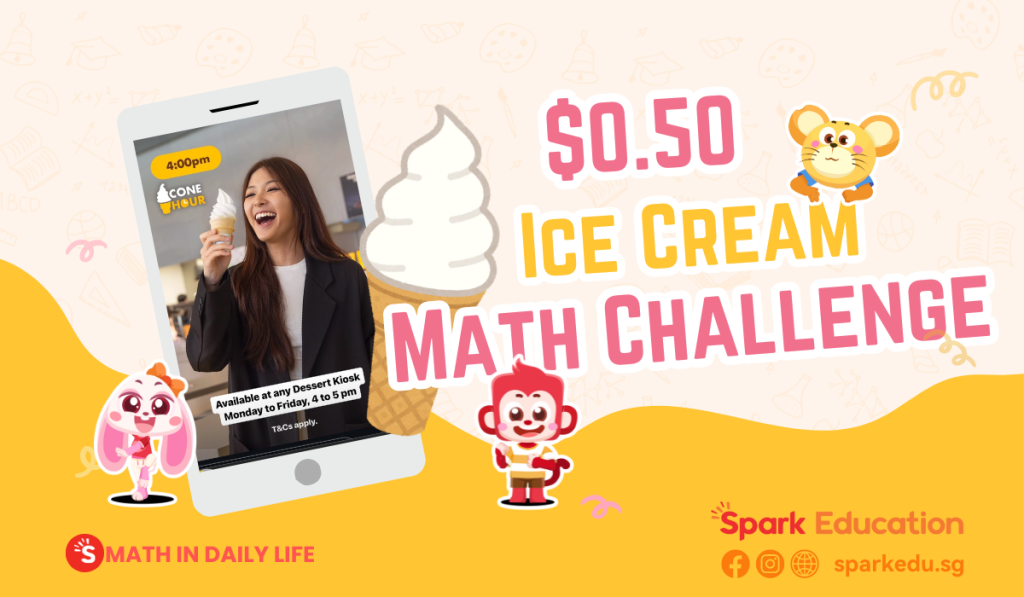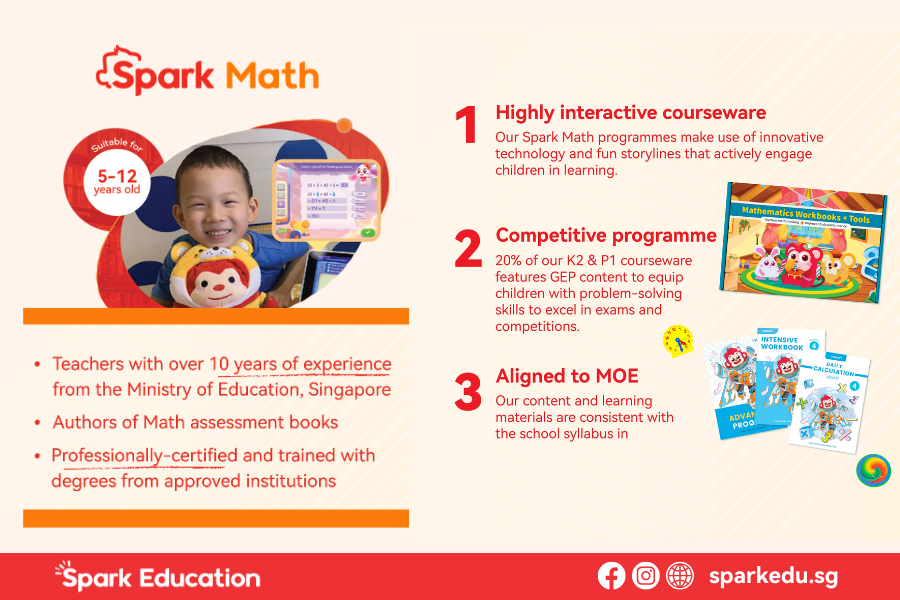Is your child excited about McDonald’s $0.50 ice cream? Why not turn this sweet treat into a fun math lesson? Discover how our Spark Math teacher turns Cone Hour into a tasty McDonald Math Challenge, making math practice enjoyable and relevant. Let’s turn those ice cream cravings into valuable math skills!

McDonald Math Challenge



Solutions
| Question 1: If you and mummy each want a vanilla cone, how many cones do you need to buy? |
Math skills tested: Addition
Solution: 1 + 1 = 2 cones
Answer: You need to buy 2 cones.
| Question 2: If you and 3 friends each buy a vanilla cone, how much money will you spend in total? |
Math skills tested: Multiplication
Solution:
- Number of people
= you + 3 friends
= 4 people - Money spend
= 4 × $0.50
= $ 2
Answer: You will spend $2 in total.
| Question 3: If you have a dollar coin, how much change will you get after buying a vanilla cone? |
Math skills tested: Money
Solution: $1.00 – $0.50 = $0.50
Answer: You’ll get 50 cents in change.
| Question 4: $0.50 is what fraction of a dollar? |
Math skills tested: Fractions and money
Solution: 50 cents is $0.50, which is half of a dollar.
Answer: The answer is 1/2.
| Question 5: If you arrive at McDonald’s at 3:30 pm, how many minutes will you wait for the promotion to start? |
Math skills tested: Time
Solution:
- You arrive at 3:30pm but the Cone Hour promotion only starts at 4 pm.
- There are 30 minutes (half an hour) from 3:30 pm to 4pm.
- So, you will wait for 30 minutes for the promotion to start.
Answer: There are 30 minutes.
| Question 6: If you have 30 coins worth 20 cents each, how many $0.50 cones can you buy? |
Math skills tested:
Multiple-step word problem involving multiplication and division
Solution:
- First, find the total amount of money you have.
- Total amount of money
= number of coins × value per coin
= 30 × $0.20
= $6
- Then, divide the total amount by the price of a cone.
- Total amount of cones
= $6 ÷ $0.50
= 12 cones
Answer: You can buy 12 discounted vanilla cones.
| Question 7: If the regular vanilla cone costs $1 and is 76.9% of the price of a ChocoCone, how much cheaper is the discounted $0.50 vanilla cone compared to the original ChocoCone price? |
Math skills tested:
Multiple-step word problem involving division, multiplication, subtraction, percentage, and decimal understanding.
Solution:
First, find the price of the ChocoCone.
- If $1 is 76.9% of the ChocoCone price (u), we can represent this as an equation:
1 = 76.9% u
u = $1 ÷ 76.9% ≈ $1.30 (round up to the nearest cent)
Then, find the price difference.
- Subtract the discounted vanilla cone price from the ChocoCone price
= $1.30 – $0.50
= $0.80
Answer: The discounted vanilla cone is $0.80 cheaper than a regular ChocoCone.
| Question 8: (a) If each family member buys one $0.50 cone every day this week, how much will your family spend in total? (b) If the regular price of a cone is $1, how much does your family save with the discount this week? |
Math skills tested:
Multiple-step multiplication and subtraction
Solution:
The answer depends on the number of family members. For the following solutions, we assume there are 4 family members.
(a) Assuming the number of family members: 4 people
- Price of a discounted cone: $0.50 per cone
- Number of days in promotion: 5 days (The promotion is available only Monday through Friday, so the family can enjoy the $0.50 vanilla cones for just 5 days this week.
- Total spent
= number of family members × price per cone × number of days
= 4 × $0.50 × 5
= $10
Therefore, the family spends $10 in total this week.
(b)
- Price of a regular cone: $1 per cone
- Amount saved per cone
= Regular price – discounted price
= $1 – $0.50
= $0.50 per cone
- The total amount saved by the family in a week (5 week days)
= number of family members × price per cone × number of days
= 4 × 0.50 × 5
= $10
Therefore, the family saves $10.00 by buying discounted cones for the entire week.
Benefits of Learning Math In Real-Life Examples
Using real-life examples like those in this McDonald Math Challenge is a fun and engaging way to introduce children to the world of numbers.
Increased Relevance and Engagement
When children see how math applies to their everyday lives, it becomes more interesting and engaging for them. For instance, calculating the cost of their favorite snacks or figuring out how to share toys equally can make math feel relevant and fun. Understanding the practical uses of math can also boost your child’s confidence and motivation to learn.
Deeper Understanding of Concepts
Math can sometimes seem abstract to children. However, by connecting mathematical concepts to real-world examples, these ideas become easier to grasp. For example, sharing a pizza can help children understand fractions. Additionally, solving real-world math problems encourages critical thinking and problem-solving skills, essential for overall development.
Improved Problem-Solving Skills
Applying math to real-life situations helps children develop logical reasoning. When faced with a problem, they learn to break it down into smaller steps and find effective solutions. This skill extends beyond math and can be applied to various aspects of life. Moreover, making decisions based on numerical data or calculations is a valuable skill that children can acquire through real-world math problems.
Better Retention of Information
Children are more likely to remember math concepts when they can relate them to personal experiences. For instance, if your child helps you calculate the family’s grocery bill, they are more likely to retain information about multiplication and addition. Real-world examples provide a context for mathematical concepts, making them easier to recall in the long term.
Real-world Application
Learning math through practical examples prepares children for the challenges they will encounter in life. From managing personal finances to understanding scientific concepts, math is essential. By incorporating real-world problems into math education, we can help children develop financial literacy, such as budgeting and understanding discounts. These skills are invaluable for making informed decisions throughout their lives.

Spark Math by Spark Education
Spark Math by Spark Education offers a comprehensive approach to math learning, combining technology, expert instruction, and real-world application. By aligning its curriculum with the Singapore MOE Syllabus, Spark Math ensures that students are mastering essential math concepts. Live teachers facilitate small group classes, providing personalized attention and fostering a collaborative learning environment.
Through interactive lessons and engaging activities, Spark Math brings math to life, helping students connect abstract concepts to real-world situations. This holistic approach empowers students to develop strong problem-solving skills and a deep understanding of mathematics.
Ready to see Spark Math in action? Sign up for a free trial class today and watch your child’s math skills soar!




